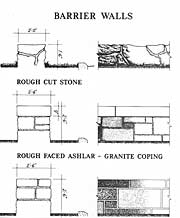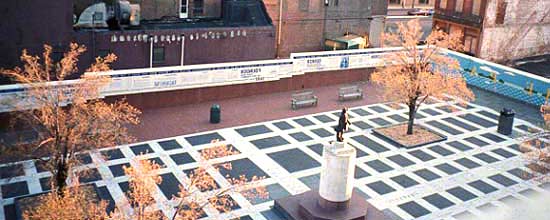

Guidelines for Rehabilitating Cultural Landscapes
Structures, Furnishings, + Objects

Identify, Retain, and Preserve Historic Features and Materials
![]()
Identifying, retaining and preserving existing buildings, structures, furnishings and objects prior to beginning project work. For example, gazebos and bridges, playground equipment and drinking fountains, benches and lights, and statuary and troughs. Documenting the relationship of these features to each other, their surrounds, and their material compositions.
Evaluating the condition and determining the age of structures, furnishings and objects. For example, utilizing Historic Structure Inventories and historic aerial photographs to understand the relationship of barns, windmills, silos and water troughs in a ranch compound or the placement of light standards and benches along park paths.
Retaining the historic relationships between the landscape and its buildings, structures, furnishings and objects.
![]()
Undertaking project work that impacts buildings, structures, furnishings, and objects without executing an “existing conditions” survey.
Undertaking work without understanding the significance of structures, furnishings and objects. For example, removing an arbor that defines the axis of a garden or fence posts that delineate the limits of a vineyard.
Removing or relocating structures, furnishings and objects, thus destroying or diminishing the historic relationship between the landscape and these features. For example, relocating a bridge from its historic crossing point or relocating a historic flagpole to a new location.
Protect and Maintain Historic Features and Materials
![]()
Protecting and maintaining buildings, structures, furnishings and objects by use of non-destructive methods and daily, cyclical and seasonal tasks. This may include rust or limited paint removal, and reapplication of protective coating systems. For example, painting metal wrought iron fences or repointing masonry to match original mortar material, color and profiles.
![]()
Failing to undertake preventive maintenance for structures, furnishings and objects, resulting in their damage or loss. For example, failing to stop water infiltration at roofs and foundations.
Utilizing maintenance practices and materials that are harsh, abrasive, or unproven. For example, using only aggressive and potentially damaging cleaning methods such as grit blasting on wood, brick, or soft stone or using harsh chemicals on masonry or metals.
Repair Historic Features and Materials
![]()
Repairing features and materials of buildings, structures, furnishings or objects by reinforcing historic materials. For example, returning a children’s swing to good working order, or reshaping a section of a deformed monkey bar.
![]()
Replacing or destroying a feature of structures, furnishings or objects when repair is possible. For example, replacing a pavilion’s tile roof with physically or visually incompatible roofing; or, removing a non-working historic light fixture, rather than rewiring it.
Replace Deteriorated Historic Materials and Features
![]()
Using existing physical evidence of form, material and detailing to reproduce a deteriorated structure, furnishing or object. If using the same kind of material is not technically, economically, or environmentally feasible, then a compatible substitute material may be considered. For example, replacing a cast stone bench with a new casting from the original mould.
![]()
Removing a structure, furnishing, or object that is deteriorated and not replacing it, or replacing it with a new feature that does not convey the same visual appearance. For example, removing a wooden rustic footbridge and replacing it with a concrete bridge.
Design for the Replacement of Missing Historic Features
![]()
Designing and installing new structures, furnishings and objects when the historic features are missing. It may be an accurate restoration using historical, pictorial and physical documentation; or be a new design that is compatible with the historic character of the landscape. For example, replacing a picnic shelter with one of a new compatible design.
![]()
Creating a false historical appearance because the replaced feature is based on insufficient historical, pictorial and physical documentation.
Introducing a new design that is incompatible with the historic character of the landscape. For example, replacing a lost wooden fence with chain link fence.
Alterations/Additions for the New Use
![]()
Designing and installing a new structure, furnishing or object when required by the new use, which is compatible with the preservation of the historic character of the landscape. For example, constructing a new farm outbuilding utilizing traditional building materials or installing appropriately scaled and detailed signage.
![]()
Placing a new structure, furnishing, or object where it may cause damage, or is incompatible with the historic character of the landscape. For example, constructing a new maintenance facility in a primary space.
Locating any new structure, furnishing or object in such a way that it detracts from or alters the historic character of the landscape. For example, installing a “period” gazebo that was never present in the cultural landscape.
Introducing a new structure, furnishing or object in an appropriate location, but making it visually incompatible in mass, scale, form, features, materials, texture or color. For example, constructing a visitors’ center that is incompatible with the historic character of the cultural landscape.
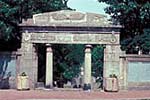
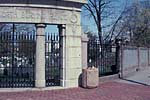
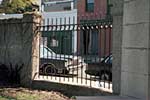
A section of the wall surrounding the Dorchester North Burying Ground in Massachusetts was in a state of advanced deterioration. [left] Rather than reconstruct the failing wall along the main entrance area, only its piers were replaced. [center] The area of wall between these piers was replaced with an iron fence. [right] This approach was selected to improve the perceived safety and security of the burial ground, thus allowing for visual access into the burial ground, where it was previously enclosed. (NPS, 1993 and Boston Parks)
[top] For some landscapes that have little remaining integrity, yet significant historical associations, a new design, complete with three-dimensional interpretive tools may highlight a landscape’s history to a visiting public. Two representative examples include Franklin Court and Welcome Park in Philadelphia, Pennsylvania. These solutions include the “ghosting” of historic structures based on archeological investigations, on three-dimensional objects, and a variety of signage. (NPS)
All parkway furnishings along the George Washington Parkway were inventoried prior to rehabilitation work. The parkway, which spans over forty years of construction between 1929 and 1970, includes a variety of construction techniques for its barrier walls. These construction details are now being utilized to aid in current repair work. (HABS)
